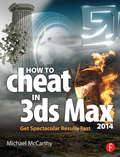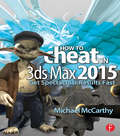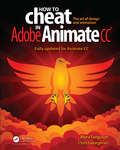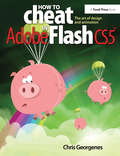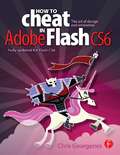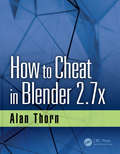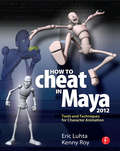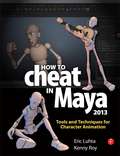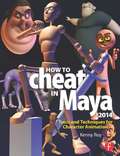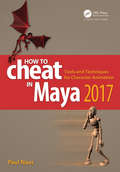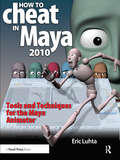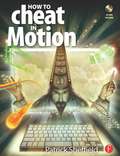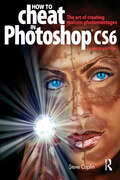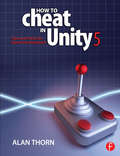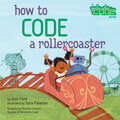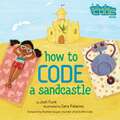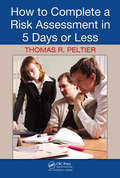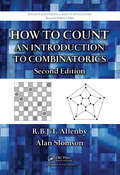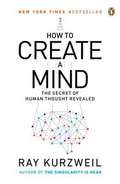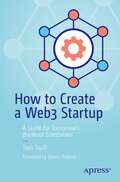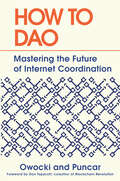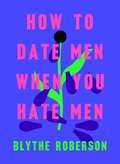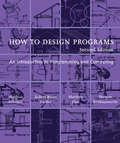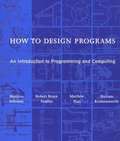- Table View
- List View
How to Cheat in 3ds Max 2014: Get Spectacular Results Fast
by Michael McCarthyWhy take months to learn every button in 3ds Max when you can create great visuals with just a few key tools? Utilize the tool of choice, 3ds Max 2014, for generating realistic environments, seamless CG effects, and jaw dropping games in a matter of hours. You can use the memory-hogging methods that choke your display and take forever to render, or you can get it done quickly and efficiently. Michael McCarthy offers a goldmine of artistic inspiration, timesaving tips & tricks, and step-by-step walkthroughs—you’ll wonder how you every got by without it! Start animating today with detailed tutorials, source files, bitmaps, and video demonstrations—all featured on the companion website. This new edition has been completely revamped for 3ds Max 2014. You will find coverage on brand new features and tools such as Scene Management, iRay, Nitrous, Mass FX, and particles and physics. How to Cheat in 3ds Max 2014 features interviews with industry professionals that will help you gain the edge you need in the competitive world of animation. 3ds Max luminary and recipient of the 2011 Autodesk 3ds Max Master Award, author Michael McCarthy shares his 3ds Max secrets and little-known tips and tricks that save users hours of time Includes all new content and advanced cheats on modelling, special effects, natural elements, and the particle system Proven How to Cheat series teaches how to create quick yet stunning special effects, animations, realistic textures, and game elements
How to Cheat in 3ds Max 2015: Get Spectacular Results Fast (How To Cheat)
by Michael McCarthyWhy take months to learn every button in 3ds Max when you can create great visuals with just a few key tools? Utilize the tool of choice, 3ds Max 2015, for generating realistic environments, seamless CG effects, and jaw dropping games in a matter of hours. You can use the memory-hogging methods that choke your display and take forever to render, or you can get it done quickly and efficiently. <P><P> Michael McCarthy offers a goldmine of artistic inspiration, timesaving tips & tricks, and step-by-step walkthroughs—you’ll wonder how you every got by without it! This new edition has been completely revamped for 3ds Max 2015. Start animating today with detailed tutorials, source files, bitmaps, and video demonstrations—all featured on the companion website.
How to Cheat in Adobe Animate CC (How To Cheat)
by Myra Ferguson Chris GeorgenesWould you rather take months to learn every tool, every feature, and every concept in Adobe Animate or start right now making your own creations with just a few steps? Myra Ferguson is teaming up with Chris Georgenes to help you create great animation, bring objects to life with cool motion effects, and enhance your productivity in Animate CC! How to Cheat in Adobe Animate CC is a goldmine of artistic inspiration, time-saving practical tips, and step-by-step walkthroughs. Let your sasquatch sunbathe, your coyote howl, and your lint spider see the light of day. With real-world projects and project source files, you can follow along and try for yourself. This book includes all NEW content and cheats for Animate CC, such as making cinemagraphs, creating a double exposure effect, speeding up the process of making real life doodles, simulating a bokeh effect, converting your documents to HTML5, and more. Key Features • Glimpse into the workflow of digital media and animation experts and apply practical techniques and tips to your own projects with source files, examples, and tutorials. • Learn a myriad of tricks based on real-life working methods to help you work faster and more efficiently with new features in Adobe Animate CC and the Creative Cloud. • Work from the problem to the solution to gain the best possible results from Animate.
How to Cheat in Adobe Flash CS5: The Art of Design and Animation (How To Cheat In Ser.)
by Chris GeorgenesNeed to solve problems quickly to develop creative projects to time and to budget? Want to hone your Flash skills so you can concentrate on your animation? Then How to Cheat in Flash is for you! Chris Georgenes shows how to work from the problem to the solution - from the viewpoint of an animator who has been commissioned to create a job and is working to a deadline and to a budget. With his in-depth knowledge of the little-known secrets used by the pros to produce creative, professional animations, Chris is the go-to guru for designers and animators who want to create great animation, applications or motion design with Flash. Fully updated for CS5, How to Cheat in Flash CS5, is a goldmine of artistic inspiration, timesaving practical tips, tricks and step-by-step workthroughs that you'll wonder how you survived without it. Each techniques is designed as a double-page spread so you can prop the book up behind your keyboard or next to your monitor as a visual reference while working alongside it. Many of these workthroughs are real-world client projects, with the source files supplied for you to open and explore. With these real-life professional projects you'll discover how to: bring objects to life with cool motion effects, make it rain, snow or set your world ablaze, develop flash mobile applications and many more tips and tricks not found anywhere else!
How to Cheat in Adobe Flash CS6: The Art of Design and Animation
by Chris GeorgenesEditor's note, 1/15/2013: We have discovered an error with the Table of Contents and are currently working on correcting it. If you find an error in your book, please visit the companion site http://www.focalpress.com/books/details/9780240522500/ for the correct version. Whether you are creating an animated short, catchy and fun cartoon or mobile game, save time and money with expert cheats by renowned Flash Expert, Chris Georgenes with all new content for the Flash CS6 revision. With practical applications and step by step tutorials solve problems quickly to develop creative projects to time and to budget. Many of these walkthroughs are real-world client projects, with the source files supplied for you to open and explore. With these real-life professional projects you'll discover how to: bring objects to life with cool motion effects, make it rain, snow or set your world ablaze, develop flash mobile applications and many more tips and tricks not found anywhere else! With his in-depth knowledge of the little-known secrets used by the pros to produce creative, professional animations, Chris is the go-to guru for designers and animators who want to create great animation, applications or motion design with Flash. Fully updated for CS6, How to Cheat in Flash CS6, is a goldmine of artistic inspiration, timesaving practical tips, tricks and step-by-step walkthroughs that you'll wonder how you survived without it. New! CS6 cheats and examples with practical solutions for the busy animator with a focus on Action Script, Flash for mobile applications, specifically for Android development, as well as a focus on an improved physics engine. Put the Adobe Flash CS6 cheats to the test with the fully updated companion website with downloadable Flash source files, examples and video tutorials, and a creative commons game, developed with Adobe, to demonstrate the new functionality of CS6!
How to Cheat in Blender 2.7x (How To Cheat)
by Alan ThornBlender is a vast and customizable 3D-modeling application used by many artists across creative industries, from television to games. This newest book, in Alan Thorn’s How to Cheat series, offers insightful and bite-sized power-tips to help you develop Blender mastery. More than five hundred figures illustrate interesting shortcuts and clever ways to improve your Blender workflow. A companion website at http://www.alanthorn.net provides bonus content, including videos and resources to help sharpen your skills further. How to Cheat in Blender 2.7x is for Blender users of all levels, offering time-saving tips and powerful techniques to increase your productivity. Key Features Bite-sized tips and tricks that can be read in any order Illustrated examples and step-by-step guides for improving your workflow Explores practical applications and real-world contexts Demonstrates "lesser-known" and unconventional tips Improves your efficiency and workflow
How to Cheat in Maya 2012: Tools and Techniques for Character Animation
by Eric LuhtaThe Maya guide for animators, How to Cheat in Maya 2012 presents everything you need to know about character animation in Maya. Fully updated for the latest revision of Maya, this book provides you with complete, step-by-step walkthroughs of essential animation techniques to increase your efficiency and speed. This is an animator's workflow in book form, written by professional animators-not a software book with a few animation pointers thrown in. In addition to all the gold-mine coverage and interviews with expert animators from the previous edition, How to Cheat in Maya 2012 also features a new in-depth chapter on the principles of animation, updated information on camera settings and animation using Maya's new Camera Sequencer tool, the ins and outs of the brand new Editable Motion Trails tool, new techniques for working with characters in multi-shot animation tests and short films, a new cycles chapter covering actions like flying and walks, time-saving scripts, and advanced tricks with the new Graph Editor. The proven "How to Cheat" series gets you up to speed quickly, and in a way that's fun.
How to Cheat in Maya 2013: Tools and Techniques for Character Animation
by Kenny Roy Eric LuhtaAll professional animators know a handful of secrets that give them an edge in a production environment. "How to Cheat in Maya" puts these secrets in your hands! Learn time and energy saving techniques tested in real Hollywood productions in this book, jam-packed with screenshots and scene files designed to get you up to speed quickly. From menus to modeling, lipsync to lighting, How to Cheat in Maya 2013 covers all of the methods available in the latest version of Maya. Get up to speed quickly and produce stellar results with these insider workflows. With new, updated cheats for the latest version of Maya, "How to Cheat in Maya" is an essential guide for amateur and professional 3D animators alike. Fulyl updated with gold-mine coverage including: expanded sections on production workflow, all new chapters covering rigging cheats and Maya's referencing tools, and brand new project files demonstrating production-proven techniques. The companion website includes complete scene files for exercises and techniques, extra rigs, Quicktime movies of full projects, and video tutorials.
How to Cheat in Maya 2014: Tools and Techniques for Character Animation
by Kenny RoyAll professional animators know a handful of secrets that give them an edge in a production environment. "How to Cheat in Maya" puts these secrets in your hands! Learn time and energy-saving techniques tested in real Hollywood productions in this book, jam-packed with screenshots and scene files designed to get you up to speed quickly. <P><P>From menus to modeling, lipsync to lighting, How to Cheat in Maya 2014 covers all of the methods available in the latest version of Maya. Get up to speed quickly and produce stellar results with these insider workflows. With new, updated cheats for the latest version of Maya, How to Cheat in Maya 2014 is an essential guide for amateur and professional 3D animators alike. Fully updated with gold-mine coverage including: expanded sections on production workflow, all new chapters covering rigging cheats and Maya's referencing tools, and brand new project files demonstrating production-proven techniques. <P><P>The companion website includes complete scene files for exercises and techniques, extra rigs, Quicktime movies of full projects, and video tutorials.
How to Cheat in Maya 2017: Tools and Techniques for Character Animation (How To Cheat)
by Paul NaasThis is not a book about Maya software with a few animation pointers thrown in here and there. This is a guide to Maya software written by professional animators. This book provides you with complete, set-by-step walkthroughs of essential animation techniques that increase your speed and efficiency while using Maya 2017 for character animation. From curves to constraints, this book covers all of the methods available in the latest version of Maya. Featuring gold-mine coverage this book teaches you new techniques for working with characters in animation tests and short films. Accompanied by a companion site, this is the one and only guide to get you up to speed. <P><P>Key Features <li>Complete step-by-step, walkthroughs of essential techniques every animator needs to know. <li>Features interviews with leading experts and experienced animation leads. <li>Companion web site including all exercise/example scene files and extras such as video tutorials and animation files. <li>Interlude articles covering everything from Reference Video to Resumes.
How to Cheat in Maya: Tools and Techniques for the Maya Animator (How To Cheat In Ser.)
by Eric LuhtaTake your animations to the next level with this essential guide to Maya 2010. Packed with character animation techniques and the secrets of professional animators, How to Cheat in Maya 2010 provides the tips and tools to help you create high quality animation in the most efficient way possible. This comprehensive guide to animating with Maya contains gold-mine coverage, including animation techniques, using Maya's tools with the 12 animation principles, working with constraints, and even foolproof lighting tricks to show off your work. With this essential handbook, learn which circumstances call for which techniques, and how to get quality results fast. You will not only learn how to be productive in Maya, but also be given access under the hood to the actual scene files of a professional animator. Covering such topics such as pose to pose blocking, layered animation, fixing gimbal lock, facial animation, and much more, How to Cheat in Maya 2010 is an invaluable resource for artists and animators alike.-- See "under the hood" of a professional animator's workflow with beginning and ending scene files for every technique and workflow example in the book. --Complete, step-by-step walkthroughs of essential techniques every animator needs to know such as walk cycles, pose-to-pose blocking, lip syncing to dialogue, and much, much more.-- Proven "How to Cheat" series - Learn to create impressive, appealing animations using the fastest techniques possible, containing everything you need to know about Maya as a character animator.--Includes rarely discussed topics, such as reading spline curves, avoiding gimbal lock, animation layers, creating appealing lighting for demo reels, and features interviews with some of the most experienced animation leads and TDs working in the industry -- Learn to apply these professional techniques to your own animations with the accompanying downloadable resources which include all scene files to follow along with, as well as final versions to study in the Graph Editor
How to Cheat in Motion
by Patrick SheffieldThe text provides a "cookbook" style of learning computer animation, presenting the user with specific recipes to achieve desirable outcomes. This practical guide helps readers to enhance titles, motion graphics and visual effects with Motion. Step-by-step instruction is concisely described and lavishly illustrated.
How to Cheat in Photoshop CS6: The art of creating realistic photomontages
by Steve CaplinWith enough charm and wit to make learning Photoshop anything but taxing, Steve Caplin delivers the next instalment of the How to Cheat series, containing all the techniques you need to create and master the art of photomontage. Delivered in easy to follow step-by-step tutorials How to Cheat in Photoshop covers all the basics of selections and layers before moving onto top tricks and techniques for creating realistic works of art for business, pleasure, or something in between. An accompanying DVD is packed full of practice images and tutorial movies for you to working along with, plus bonus chapters to push your skills even further. Using a tweaked design that is clearer and fresher than previous editions this is the funnest way to master Photomontage.
How to Cheat in Unity 5: Tips and Tricks for Game Development
by Alan ThornLooking to become more efficient using Unity? <P><P>How to Cheat in Unity 5 takes a no-nonsense approach to help you achieve fast and effective results with Unity 5. Geared towards the intermediate user, HTC in Unity 5 provides content beyond what an introductory book offers, and allows you to work more quickly and powerfully in Unity. Packed full with easy-to-follow methods to get the most from Unity, this book explores time-saving features for interface customization and scene management, along with productivity-enhancing ways to work with rendering and optimization. In addition, this book features a companion website at www.alanthorn.net, where you can download the book’s companion files and also watch bonus tutorial video content. <P><P>Learn bite-sized tips and tricks for effective Unity workflows <P><P>Become a more powerful Unity user through interface customization <P><P>Enhance your productivity with rendering tricks, better scene organization and more <P><P>Better understand Unity asset and import workflows <P><P>Learn techniques to save you time and money during development
How to Code a Rollercoaster
by Josh FunkPearl and Pascal take their coding adventures to the amusement park in this follow-up picture book from our Girls Who Code program!Pearl and her trusty rust-proof robot, Pascal, are enjoying a day out at the amusement park. Spinning teacups, ice cream, and of course: rollercoasters! Through the use of code, Pearl and Pascal can keep track of their ride tokens and calculate when the line is short enough to get a spot on the biggest ride of them all--the Python Coaster. Variables, if-then-else sequences, and a hunt for a secret hidden code make this a humorous, code-tastic day at the amusement park!
How to Code a Sandcastle
by Josh FunkFrom the computer science nonprofit Girls Who Code comes this lively and funny story introducing kids to computer coding concepts.All summer, Pearl has been trying to build the perfect sandcastle, but out-of-control Frisbees and mischievous puppies keep getting in the way! Pearl and her robot friend Pascal have one last chance, and this time, they&’re going to use code to get the job done. Using fundamental computer coding concepts like sequences and loops, Pearl and Pascal are able to break down their sandcastle problem into small, manageable steps. If they can create working code, this could turn out to be the best beach day ever! With renowned computer science nonprofit Girls Who Code, Josh Funk and Sara Palacios use humor, relatable situations, and bright artwork to introduce kids to the fun of coding.
How to Complete a Risk Assessment in 5 Days or Less
by Thomas R. PeltierSuccessful security professionals have had to modify the process of responding to new threats in the high-profile, ultra-connected business environment. But just because a threat exists does not mean that your organization is at risk. This is what risk assessment is all about. How to Complete a Risk Assessment in 5 Days or Less demonstrates how to identify threats your company faces and then determine if those threats pose a real risk to the organization. To help you determine the best way to mitigate risk levels in any given situation, How to Complete a Risk Assessment in 5 Days or Less includes more than 350 pages of user-friendly checklists, forms, questionnaires, and sample assessments. Presents Case Studies and Examples of all Risk Management Components based on the seminars of information security expert Tom Peltier, this volume provides the processes that you can easily employ in your organization to assess risk. Answers such FAQs as: Why should a risk analysis be conducted Who should review the results? How is the success measured? Always conscious of the bottom line, Peltier discusses the cost-benefit of risk mitigation and looks at specific ways to manage costs. He supports his conclusions with numerous case studies and diagrams that show you how to apply risk management skills in your organization-and it's not limited to information security risk assessment. You can apply these techniques to any area of your business. This step-by-step guide to conducting risk assessments gives you the knowledgebase and the skill set you need to achieve a speedy and highly-effective risk analysis assessment in a matter of days.
How to Count: An Introduction to Combinatorics, Second Edition
by R.B.J.T. Allenby Alan SlomsonEmphasizes a Problem Solving ApproachA first course in combinatoricsCompletely revised, How to Count: An Introduction to Combinatorics, Second Edition shows how to solve numerous classic and other interesting combinatorial problems. The authors take an easily accessible approach that introduces problems before leading into the theory involved. Although the authors present most of the topics through concrete problems, they also emphasize the importance of proofs in mathematics.New to the Second EditionThis second edition incorporates 50 percent more material. It includes seven new chapters that cover occupancy problems, Stirling and Catalan numbers, graph theory, trees, Dirichlet's pigeonhole principle, Ramsey theory, and rook polynomials. This edition also contains more than 450 exercises. Ideal for both classroom teaching and self-study, this text requires only a modest amount of mathematical background. In an engaging way, it covers many combinatorial tools, such as the inclusion-exclusion principle, generating functions, recurrence relations, and Polya's counting theorem.
How to Create a Mind: The Secret of Human Thought Revealed
by Ray KurzweilThe bestselling author of The Singularity Is Near explores the limitless potential of reverse-engineering the human brain Ray Kurzweil is arguably today's most influential futurist. In How to Create a Mind, he presents a provocative exploration of the most important project in the human-machine civilization: reverse-engineering the brain to understand precisely how it functions and using that knowledge to create even more intelligent machines. Kurzweil discusses how the brain works, how the mind emerges, brain-computer interfaces, and the implications of vastly increasing the powers of our intelligence to address the world's problems. Certain to be one of the most widely discussed and debated science books of the year, How to Create a Mind is sure to take its place alongside Kurzweil's previous classics.
How to Create a Mind: The Secret of Human Thought Revealed
by Ray KurzweilThe bold futurist and bestselling author explores the limitless potential of reverse-engineering the human brainRay Kurzweil is arguably today’s most influential—and often controversial—futurist. In How to Create a Mind, Kurzweil presents a provocative exploration of the most important project in human-machine civilization—reverse engineering the brain to understand precisely how it works and using that knowledge to create even more intelligent machines.Kurzweil discusses how the brain functions, how the mind emerges from the brain, and the implications of vastly increasing the powers of our intelligence in addressing the world’s problems. He thoughtfully examines emotional and moral intelligence and the origins of consciousness and envisions the radical possibilities of our merging with the intelligent technology we are creating.Certain to be one of the most widely discussed and debated science books of the year, How to Create a Mind is sure to take its place alongside Kurzweil’s previous classics which include Fantastic Voyage: Live Long Enough to Live Forever and The Age of Spiritual Machines.From the Hardcover edition.
How to Create a Web3 Startup: A Guide for Tomorrow’s Breakout Companies
by Tom TaulliWeb3 is the next evolution for the World Wide Web based on Blockchain technology. This book will equip entrepreneurs with the best preparation for the megatrend of Web3 by reviewing its core concepts such as DAOs, tokens, dApps, and Ethereum.With Web2, much of the valuable data and wealth has been concentrated with a handful of mega tech operators like Apple, Facebook, Google and Amazon. This has made it difficult for startups to get an edge. It has also meant that users have had little choice but to give up their value data for free. Web3 aims to upend this model using a decentralized approach that is on the blockchain and crypto. This allows for users to become stakeholders in the ecosystem. Along with exploring core concepts of Web3 like DAOs, tokens, dApps, and Ethereum, this book will also examine the main categories that are poised for enormous opportunities. They include infrastructure, consumer apps, enterprise apps, and the metaverse. For each of these, I will have use cases of successful companies. How To Create a Web3 Startup covers the unique funding strategies, the toolsets needed, the talent required, the go-to-market approaches, and challenges faced. What You'll LearnWork with the dev stack componentsExamine the success factors for infrastructure, consumer, enterprise, verticals, and the MetaverseUnderstand the risks of Web3, like the regulatory structure and security breachesWho This Book Is ForStartup entrepreneurs and those looking to work in the Web3 industry.
How to DAO: Mastering the Future of Internet Coordination
by Kevin Owocki PuncarWelcome to the future of internet coordination.By now you&’ve heard the buzz about Decentralized Autonomous Organizations (DAOs), and how they are going to redefine how we work and earn.But when you peel away the hype and tech jargon, what are they really? How do they operate, why do they matter, and how can we all thrive in this brave new world of work?In How to DAO, industry veterans Kevin Owocki and Puncar take you on an illuminating journey into the world of groundbreaking change, exploring the principles of decentralized finance, and teaching the brass tacks of setting up and managing your own DAO, from smart contracts to governance and innovation.With How to DAO, discover what DAOs are really about, and learn the tips and tricks you need to harness the limitless potential of this transformative new technology.
How to Date Men When You Hate Men
by Blythe RobersonFrom New Yorker and Onion writer and comedian Blythe Roberson, How to Date Men When You Hate Men is a comedy philosophy book aimed at interrogating what it means to date men within the trappings of modern society. Blythe Roberson’s sharp observational humor is met by her open-hearted willingness to revel in the ugliest warts and shimmering highs of choosing to live our lives amongst other humans. She collects her crushes like ill cared-for pets, skewers her own suspect decisions, and assures readers that any date you can mess up, she can top tenfold. And really, was that date even a date in the first place?With sections like Real Interviews With Men About Whether Or Not It Was A Date; Good Flirts That Work; Bad Flirts That Do Not Work; and Definitive Proof That Tom Hanks Is The Villain Of You’ve Got Mail, How to Date Men When You Hate Men is a one stop shop for dating advice when you love men but don't like them."With biting wit, Roberson explores the dynamics of heterosexual dating in the age of #MeToo"— The New York Times
How to Design Programs, second edition: An Introduction to Programming and Computing (The\mit Press Ser.)
by Matthias Felleisen Robert Bruce Findler Shriram Krishnamurthi Matthew FlattA completely revised edition, offering new design recipes for interactive programs and support for images as plain values, testing, event-driven programming, and even distributed programming.This introduction to programming places computer science at the core of a liberal arts education. Unlike other introductory books, it focuses on the program design process, presenting program design guidelines that show the reader how to analyze a problem statement, how to formulate concise goals, how to make up examples, how to develop an outline of the solution, how to finish the program, and how to test it. Because learning to design programs is about the study of principles and the acquisition of transferable skills, the text does not use an off-the-shelf industrial language but presents a tailor-made teaching language. For the same reason, it offers DrRacket, a programming environment for novices that supports playful, feedback-oriented learning. The environment grows with readers as they master the material in the book until it supports a full-fledged language for the whole spectrum of programming tasks.This second edition has been completely revised. While the book continues to teach a systematic approach to program design, the second edition introduces different design recipes for interactive programs with graphical interfaces and batch programs. It also enriches its design recipes for functions with numerous new hints. Finally, the teaching languages and their IDE now come with support for images as plain values, testing, event-driven programming, and even distributed programming.
How to Design Programs: An Introduction to Programming and Computing
by Matthias Felleisen Robert Bruce Findler Shriram Krishnamurthi Matthew FlattThis introduction to programming places computer science in the core of a liberal arts education. Unlike other introductory books, it focuses on the program design process. This approach fosters a variety of skills--critical reading, analytical thinking, creative synthesis, and attention to detail--that are important for everyone, not just future computer programmers. The book exposes readers to two fundamentally new ideas. First, it presents program design guidelines that show the reader how to analyze a problem statement; how to formulate concise goals; how to make up examples; how to develop an outline of the solution, based on the analysis; how to finish the program; and how to test. Each step produces a well-defined intermediate product. Second, the book comes with a novel programming environment, the first one explicitly designed for beginners. The environment grows with the readers as they master the material in the book until it supports a full-fledged language for the whole spectrum of programming tasks. All the book's support materials are available for free on the Web. The Web site includes the environment, teacher guides, exercises for all levels, solutions, and additional projects.
